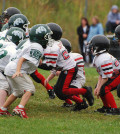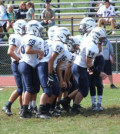- Youth football participation declines as worries mount about concussions
- NFL safety boss says the league could ban helmets one day
- Fayetteville-Manlius Pop Warner to use Guardian helmet caps beginning this season
- Youth Football has a Concussion Problem
- ‘Blindside block’ rule gains two-year trial in Oregon high school football
- Ex-Michigan LB Dhani Jones in favor of removing helmets from football for safety
- Seven tips to keep kids safe from summer heat during practice.
- Early retirement of 49ers Borland spurs discussion of youth football safety
Coaching Youth Football Special Teams
Coaching Youth Football Special Teams

Whether you are a veteran youth football coach or just beginning, coaching your team’s special teams can be a great way to improve your team’s overall game. This article will help you prepare your team for extra point kicks, and prepare your defense for fakes, containment, and coverage schemes.
Preparing your team for the second half of the game
Developing your youth football team’s special teams may be more about the way you play the game than the way you coach. The most important part of the equation is ensuring that your players get the most out of each and every play. While they are learning the ropes, there is no reason to allow them to get hurt. It is best to let them know that their role is just as important as their offensive and defensive counterparts.
A full team drill is the logical way to accomplish this. During this time, your team will practice running plays against an opposing scout team. The purpose of the drill is to get the entire team reps and get the players on the same page. This is the best way to make sure that you are maximizing your special teams. The best part is that this type of drill is fun for the players as well as the coach. Aside from getting the most out of each and every play, it also allows you to get to know your team’s unique strengths and weaknesses. You can then use this information to create a more effective game plan.
The best way to do this is to create a practice plan that you can share with every coach in your league. You can then break this plan into five, ten or fifteen minute segments that you can easily rotate between during practice. When you do, make sure that you include the most important special teams practice in the rotation.
Preparing your defense for fakes, containment, and coverage schemes
Whether you are an aspiring high school football coach or a seasoned pro, you will need to have a well oiled special team to keep the ball out of the endzone. With that in mind, you need to be aware of the latest and greatest technology available to make your job a breeze. If you are unsure of where to start, this list should be a good place to start.
First and foremost, you should know your linesmen. The best places to start are the line and the back. You don’t want to have a bunch of guys standing around waiting to get their assignments. You also don’t want your team to be stuck in the middle of the field so you should be aware of the location of your team’s goal line. Once you have your linemen squared away, you can get down to the fun stuff. Keeping your players happy is the key to a winning special team. Make sure to heed your players’ wishes and make sure you don’t forget to say thanks.
Finally, you should take the time to make your special team a success. You can’t expect them to be perfect every time, but you do want to make sure they know you’ll be there to help them out when they need it most.
Practicing extra point kicks
Practicing extra point kicks with youth football players is an important part of their development. In addition to playing defense, special teams is an important part of the youth football experience. Special teams is important because it makes a difference in many games. Special teams units are often comprised of players who are not very prominent on offense. These players are vital to the special teams team’s success.
Special teams is an important part of youth football and should be a part of the coach’s daily practice routine. It is crucial to teach youth football players how to properly block and contain kickoffs. This is especially important when a punt is returned. A punt should be blocked down to the shoulder of linemen inside of the punt team. Linemen should remain low while stepping down.
Practicing extra point kicks with youth players should involve a 4-step progression. The first step is a kickoff drill, which is great for conditioning. The drill begins with players lining up 10 yards behind the ball and sideline to sideline. The kicker will then run up to the ball and kick it.
After the kick is kicked, the kickoff team will sprint forward as if they are covering the kick. Once the players get close to the ball, another coach will throw the ball to a player who will be about 30 yards downfield. This player will then run to the kickoff location and try to recover the ball. The ball must be kicked within five seconds of the holder receiving the snap. If a player does not return the ball, it is dead.
The second step in the drill is to practice executing an onside kick. The onside kick is a kickoff drill that helps the kickoff team practice kicking the ball off. To kick an onside kick, players will line up to the right or left of the formation, depending on the kicker’s location. The players will then sprint forward to block the opponent.
Once the kick has been returned, the punt return team will line up in the kickoff location. They should have a containment defender or two on each side of the ball.
Finding a job as a youth football coach
Whether you’re looking for a position on a local club team, or you’re a new coach looking for your first job as a youth football special teams coach, there are some basic steps that you can take to land your first job. The first step is to set expectations. This prevents confusion later in the season.
The second step is to find some references. The most effective way to find references is to network with local coaching groups. These groups are typically the first place to post jobs. If you can’t find someone in your local area, you can still find coaching jobs through a Google search.
The third step is to find some experience. You can gain experience by assisting other coaches in their youth football programs. Those who are new to the field should consider joining a recreational football league. This will give them the opportunity to make friends, and learn the sport.
You can also gain experience by volunteering with teenagers. This will show that you are a positive role model to young people. You should be able to show that you have an active listening ear, and that you are dedicated to healthy behaviors and investing in your community.
You’ll also need a few coaching credentials to get a job as a youth football special teams coach. These include a first aid certificate, heat safety certification, and sports concussion certification. The specifics of certification will vary by state.
Lastly, you will need to understand the sport from a player’s perspective. Football is a physically demanding sport, and it’s important that your players understand the long hours that you will put in. This means you need to be flexible, have great organization skills, and be a great communicator.
Coaching Youth Football Special Teams
Coaching Youth Football Special Teams
Finally, you’ll need to find a good league. You can choose from a club team, a recreational league, or a select travel team league. Select travel teams are usually more difficult for first-time youth football head coaches. However, they usually allow you to work on your coaching skills more comfortably.
You may also want to consider going to a college or university to coach. This is a good way to gain experience working with high school students, and it can give you the credentials you need to stand out. https://www.youtube.com/embed/Jk9ce20k_Nw






0 comments